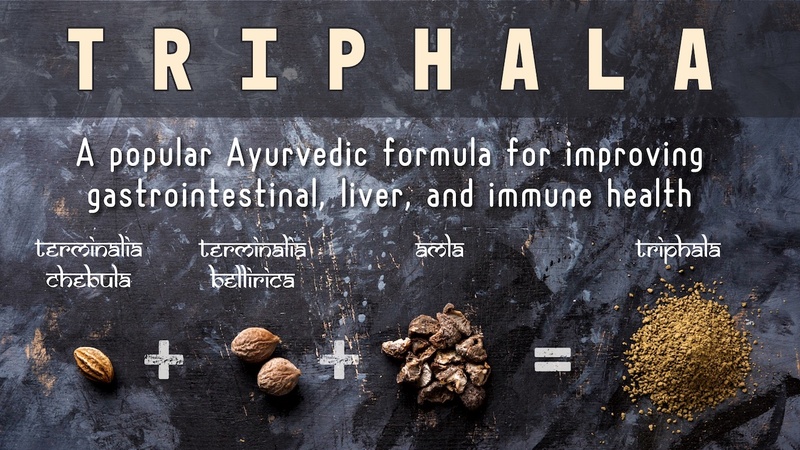
Triphala is a great example of why I tend to take herbs as part of a formula as a combination. This trio of herbal fruits is one of the most popular combinations in Ayurvedic medicine and it is so highly prized in India that there’s a saying, “No mother? Do not worry if you have Triphala.”
Properties of Triphala
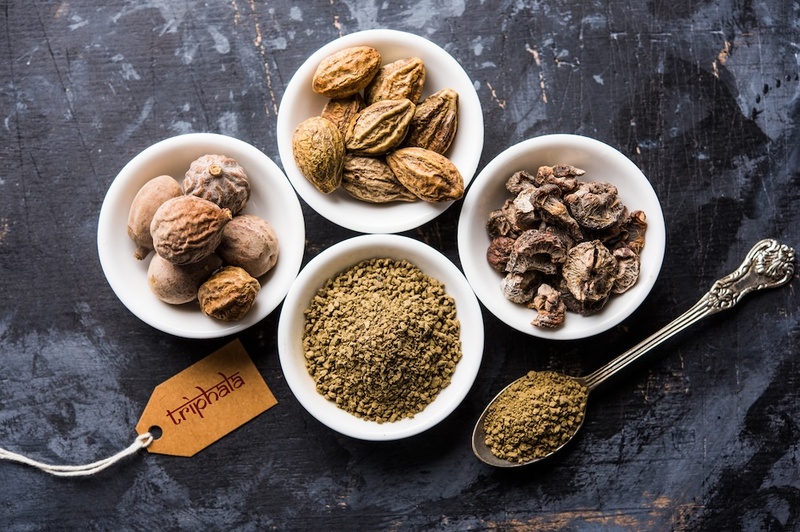 Triphala is one of the best tonics I know for the gastrointestinal tract. In Ayurvedic medicine, it is used to treat poor appetite, constipation, indigestion, and intestinal gas, and bloating. It can help to normalize intestinal dysbiosis and has a tonic effect on the intestinal membranes, making it helpful for leaky gut syndrome.
Triphala is one of the best tonics I know for the gastrointestinal tract. In Ayurvedic medicine, it is used to treat poor appetite, constipation, indigestion, and intestinal gas, and bloating. It can help to normalize intestinal dysbiosis and has a tonic effect on the intestinal membranes, making it helpful for leaky gut syndrome.
It also has hepatoprotective properties, meaning it helps protect the liver against environmental toxins. It is both antioxidant and anti-inflammatory and is believed to slow aging and protect the body against degenerative disease. It is beneficial for circulation, helps lower blood pressure, and protects the heart. It is also helpful for respiratory congestion, helping to expel mucus from the lungs and sinuses. It has a blood sugar-balancing effect and has also been used for treating eye diseases and easing joint pain.
Finally, it stimulates the immune system to fight infections. Clinical studies show thatriphala has significant immunostimulatory effects on cellular immune response, especially cytotoxic T-cells and natural killer cells.
It has all six of the tastes or flavors recognized in Ayurvedic medicine (sweet, sour, salty, bitter, pungent, and astringent) which gives it a balancing effect on the body. A similar idea is applied to schizandra in Chinese medicine because it has all the tastes recognized in TCM. It is composed of three fruits, Haritaki, Bibhitaki, and Amalaki and is completely safe to be used regularly. Here is some more detailed information on these three ingredients.
Haritaki
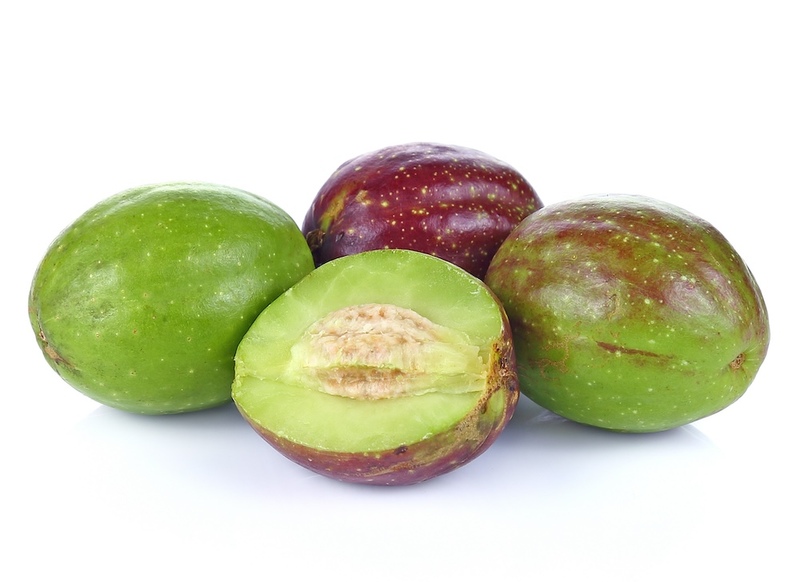 Haritaki (Terminalia chebula) is a large deciduous tree that produces an ovoid drupe (a fruit with one stony seed, like a cherry or apricot). The yellow, green, or orange-brown fruits are sometimes tinged with red or black and become hard when dried. Besides the fruits, which are used in triphilia, the bark and leaves have also been used as medicine. It is known in Tibetan medicine as the “king of medicines,” and many depictions of the healing Buddha show him extending a handful of this fruit, indicating its long-standing medicinal use in Asia.
Haritaki (Terminalia chebula) is a large deciduous tree that produces an ovoid drupe (a fruit with one stony seed, like a cherry or apricot). The yellow, green, or orange-brown fruits are sometimes tinged with red or black and become hard when dried. Besides the fruits, which are used in triphilia, the bark and leaves have also been used as medicine. It is known in Tibetan medicine as the “king of medicines,” and many depictions of the healing Buddha show him extending a handful of this fruit, indicating its long-standing medicinal use in Asia.
The fruit has all of the tastes but is primarily sweet and astringent. It has a normalizing effect on bowel function, helping to correct both diarrhea and constipation. It is antioxidant and anti-inflammatory, as well as being antibacterial, antiviral, and immune-modulating. It has hepatoprotective qualities, helping protect the body against both chemicals and radiation, and an extract has been used to help prevent anaphylactic shock.
Bibhitaki
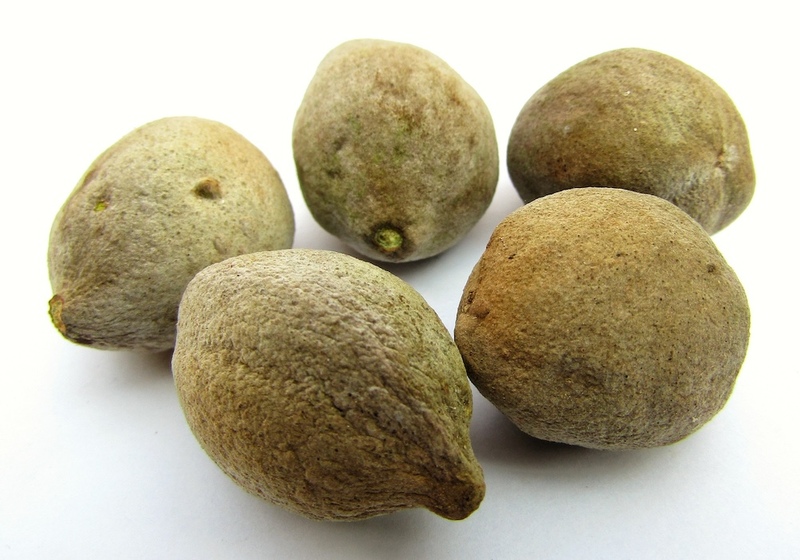 A close relative of haritaki, bibhitaki (Terminalia belerica) is also a large deciduous tree producing ovoid-shaped drupes that are grey in color. Inside the kernel is a sweet seed that is high in oil and eaten like a nut. It is known as “the one who keeps away disease” in India.
A close relative of haritaki, bibhitaki (Terminalia belerica) is also a large deciduous tree producing ovoid-shaped drupes that are grey in color. Inside the kernel is a sweet seed that is high in oil and eaten like a nut. It is known as “the one who keeps away disease” in India.
It is sweet and astringent and is considered a rejuvenating tonic for the voice, vision, and hair. It also has a strong laxative and decongestant action and has been used to treat respiratory problems where there is excess mucus, including wet asthma, bronchitis, and respiratory allergies. It is also considered antioxidant and hepatoprotective.
Amalaki
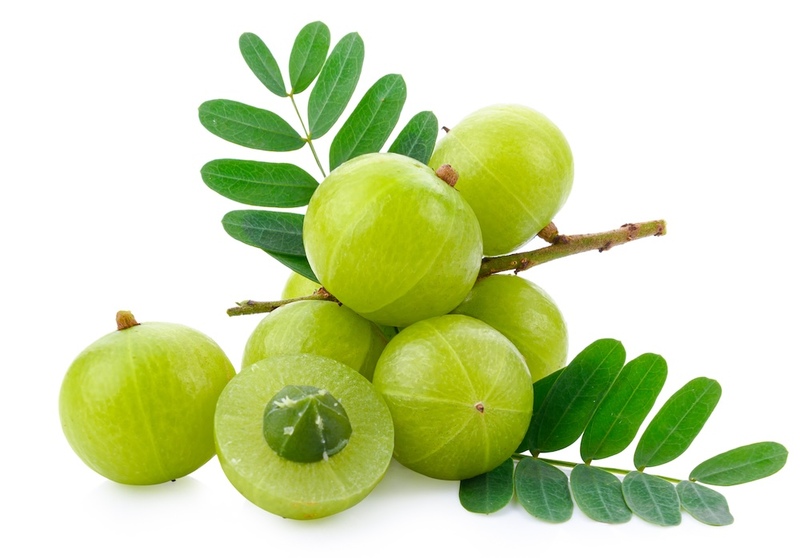 Also known as Indian gooseberry, Amalaki (Phyllanthus embilica orEmblica officinalis), is a medium-sized tree that produces hard, smooth, round drupes that are yellowish-green in color with six vertical stripes. It has sour, astringent, sweet, pungent, and bitter flavors, which gives it a balancing energy.
Also known as Indian gooseberry, Amalaki (Phyllanthus embilica orEmblica officinalis), is a medium-sized tree that produces hard, smooth, round drupes that are yellowish-green in color with six vertical stripes. It has sour, astringent, sweet, pungent, and bitter flavors, which gives it a balancing energy.
The one-inch-sized fruits have the same amount of vitamin C as two oranges. They have a balancing effect on intestinal function, helping to correct both diarrhea and constipation. It is a cooling, antioxidant, and anti-inflammatory, remedy and has been used to treat various hot conditions like ulcers, intestinal inflammation, burning sensations, skin eruptions, and infections.
Using Triphala
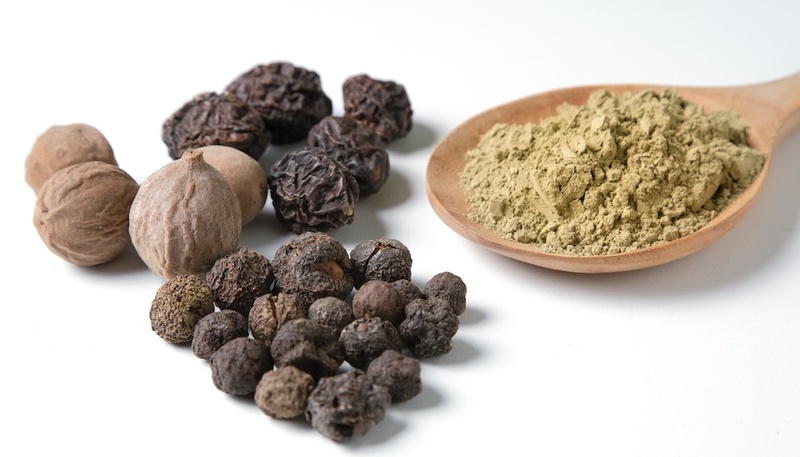 Triphala is available in both capsule and powder form. If you’re using capsules, I’d take a minimum of 2-4 capsules daily. You can also mix 1-2 grams of the powder with water or juice and drink it. I’ve also mixed equal parts psyllium hulls, freshly ground flax seed, and triphala as a bowel tonic. Start with ½ teaspoon in water or juice and work up to 1-2 teaspoons per day. This is a very good blend for softening hard, dry stools. Be sure to drink plenty of water when taking any kind of fiber product like psyllium.
Triphala is available in both capsule and powder form. If you’re using capsules, I’d take a minimum of 2-4 capsules daily. You can also mix 1-2 grams of the powder with water or juice and drink it. I’ve also mixed equal parts psyllium hulls, freshly ground flax seed, and triphala as a bowel tonic. Start with ½ teaspoon in water or juice and work up to 1-2 teaspoons per day. This is a very good blend for softening hard, dry stools. Be sure to drink plenty of water when taking any kind of fiber product like psyllium.
I helped create a Gentle Bowel Cleansing Formula for an herbal company that combines triphala with magnesium hydroxide and other herbs to create a gentle laxative formula, which I take fairly regularly. Many people have reported to me how helpful this formula has been for them. The dose is of this formula is 3-4 capsules per day. You can get a similar effect by taking 2-4 capsules of triphala with 400-800 mg of magnesium malate and/or citrate.
Downloads
Steven's Articles
-

-
The Health Benefits and Problems with Coffee
This popular caffeinated beverage can be beneficial…
October
-

-
Understanding Caffeine & Cellular Adaptation
Preserving the power of caffeine's buzz and the…
September
-

-
Horseradish
A pungent spice for aiding protein metabolism…
-

-
Banaba or Crepe Myrtle
A beautiful tree from Southeast Asia whose leaves…
August
-

-
Monkeyflowers
Flower essences to help see ourselves more clearly…
-

-
Mariposa Lilies
Strengthening the bond between mother and child…
-

-
The Noble Bay Leaf
A common kitchen herb for aiding digestion and…
-

-
Epimedium: Horny Goat Weed
A circulatory stimulant and kidney yang tonic…
July
-

-
The Medicinal and Nutritional Benefits of Apricots
A nutritious fruit and valuable medicinal seed for coughs
-

-
Dogwoods
Asian dogwood is used to stop excessive discharge,…
June
-

-
Neem: The Village Pharmacy
A popular Ayurvedic remedy for dental and immune…
-

-
Spilanthes: The Toothache Plant
A traditional remedy for teeth and gums, as well…
-

-
Forsythia
An anti-inflammatory, fever-reducing, and infection fighting herb
May
-

-
Buckwheat (Kashi)
A delicious, high protein, gluten-free, gut-healthy food
-

-
Leaky Gut Syndrome
Plugging the leaks on the underlying cause of…

